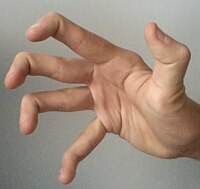
Photo from wikipedia
Background Component alignment is an important consideration in total hip arthroplasty. The impact of changes in alignment on muscle forces and joint contact forces during dynamic tasks are not well… Click to show full abstract
Background Component alignment is an important consideration in total hip arthroplasty. The impact of changes in alignment on muscle forces and joint contact forces during dynamic tasks are not well understood, and have the potential to influence surgical decision making. The objectives of this study were to assess the impact of femoral head/stem and cup component placement on hip muscle and joint contact forces during tasks of daily living and to identify which alignment parameters have the greatest impact on joint loading. Methods Using a series of strength‐calibrated, subject‐specific musculoskeletal models of patients performing gait, sit‐to‐stand and step down tasks, component alignments were perturbed and joint contact and muscle forces evaluated. Findings Based on the range of alignments reported clinically, variation in head/stem anteversion‐retroversion had the largest impact of any degree of freedom throughout all three tasks; average contact forces 413.5 (319.1) N during gait, 262.7 (256.4) N during sit to stand, and 572.7 (228.1) N during the step down task. The sensitivity of contact force to anteversion‐retroversion of the head/stem was 31.5 N/° for gait, which was similar in magnitude to anterior‐posterior position of the cup (34.6 N/m for gait). Additionally, superior‐inferior cup alignment resulted in 16.4 (4.9)° of variation in the direction of the hip joint contact force across the three tasks, with the most inferior cup placements moving the force vector towards the cup equator at the point of peak joint contact force. Interpretation A quantitative understanding of the impact and potential tradeoffs when altering component alignment is valuable in supporting surgical decision making. HighlightsHip arthroplasty alignment parameters with greatest impact on loading were identified.Subject‐specific musculoskeletal models simulating daily activities were used.Head/stem anteversion‐retroversion had the largest impact throughout all three tasks.Inferior cup placements resulted in forces towards the cup equator at peak loads.Alignment impact supports surgical decision‐making and instrumentation development.
Journal Title: Clinical Biomechanics
Year Published: 2018
Link to full text (if available)
Share on Social Media: Sign Up to like & get
recommendations!